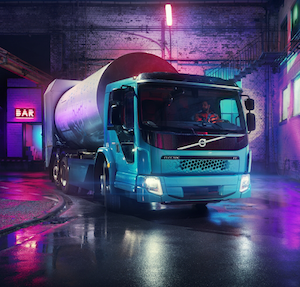Taking our electric future on - and off - the road
Anna Thordén, product manager, Electromobility for Volvo Trucks explains how buses, trucks and construction machines are steering toward an electric future.
When Volvo first started to explore electromobility back in 2005, the main driver was the need to reduce exhaust emissions and fuel consumption in our cities. But it is really over the last two years that we have seen this huge shift from local to global – with electromobility being recognized as a key tool in tackling climate change on a much wider scale. Electric trucks are vital if we are to fulfil EU legislation calling for a 15% reduction in CO2 emissions for heavy duty trucks by 2025. And that begins in our cities with buses, refuse trucks, city distribution and urban construction – all powered by electric technology.
 |
| The newly launched Volvo ECR25 Electric and L25 Electric compact machines are perfect for inner-city operations. |
 |
| The Volvo FE Electric is designed for heavier city distribution and refuse transport operations. |
 |
| The silent and clean Volvo 7900 electric bus produces no climate emissions. |
 |
| Anna Thordén, Product Manager, Electromobility, for Volvo Trucks |
By 2030, 60% of inhabitants will be living in cities. That is an increase of one billion people from today – and that will likely bring with it a huge increase in road transport.
Clearly, electric trucks and machines are needed to get to grips with congestion, reduce harmful carbon emissions, dampen noise pollution and improve quality of life and the benefits are numerous. Not only will residents and drivers enjoy a less polluted environment with zero exhaust emissions, but the drive-by noise is about 10 decibels lower compared to diesel trucks, about half the noise level. In surveys, our drivers have also reported feeling happier and more rested after a day’s work when driving an electric truck. From a safety perspective, workers can also hear what is happening around the truck much more easily.
Low noise levels also have an effect for productivity. Silent vehicles mean we probably can operate in off-peak times, reducing the amount of trucks on our roads by up to 70% during the daytime. In addition, city planners are currently exploring ways to collect refuse indoors or create interior bus stops so that the noise of loading and unloading is also removed.
Mapping the electromobility journey
Adoption will happen slowly. We tend to see it starting segment by segment and then market by market. In Volvo Group’s experience, we benefit from a shared technology platform which has allowed us to go from our first hybrid electric bus and Volvo FE Hybrid 26 ton truck in 2010, to the first fully electric bus in 2015 and now today the first compact electric machines by Volvo Construction Equipment.
Norway has been one of the earliest adopters for electric transportation – a trend that is mirrored across Northern Europe – helped as these countries are by strong subsidies and cheap and extremely green electricity and hydropower. This is the ultimate goal for electromobility. Because when you power an electric truck through renewable energy sources you can expect an 85% reduction in CO2 emissions, that’s compared to the 20% reduction achieved via a more conventional electricity mix.
We then expect the rest of Europe, certain parts of the USA, such as California, and countries like Korea and Singapore to be among the most eager to take up electromobility – whether that is because of strong emission regulations or the desire to be seen making a difference in the fight against climate change.
Purchase subsidies and tax advantages are a key incentive to encourage more people to turn to electromobility, so ensuring that government authorities, city planners and of course the companies tendering for the work are on board at an early stage will also help to further boost its appeal.
In it for the long haul
However, it isn’t all so straightforward. There are a number of hurdles to pass before electromobility can progress beyond our cities. These are:
1. Driving ranges. At the moment battery technology is not yet mature enough to handle long-haul driving ranges. When total cost of ownership comes down we will enter into more heavy construction and regional distribution and eventually progress into long-haul driving.
2. Product cost. Most components don’t come cheap, but batteries are among the most expensive – so the product cost is still high in relatively low volumes. We expect that the technology will develop fast and within the next 3-4 years the same size of battery will get double the energy it gets today, leading to a lower cost per kilowatt energy.
3. Charging. If we want to go from city applications to long-haul driving, society and businesses need to invest in the charging infrastructure. I believe that in the next 10 years, trucks will be able to complete a day’s driving on one electric charge. And when that happens that is a huge step forward in range, payload and cost.
The FL and FE Electric truck and electric machines by Volvo Construction Equipment that are on the market today are not just new models – they are paving the way toward a future that is less polluted, safer and more efficient.
Anna Thordén is product manager for Electromobility at Volvo Trucks. Prior to this, she worked as chief project manager at Volvo GTT, mainly on electromobility projects.








